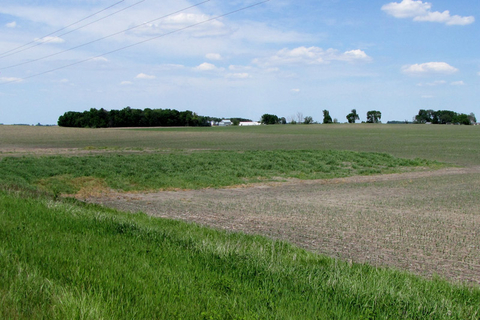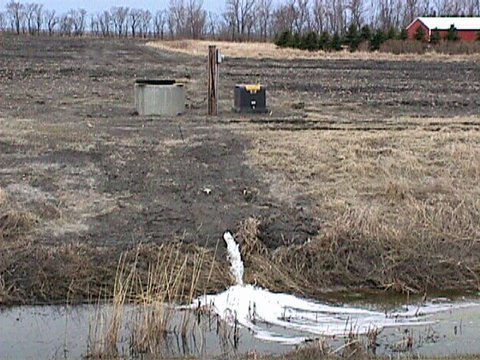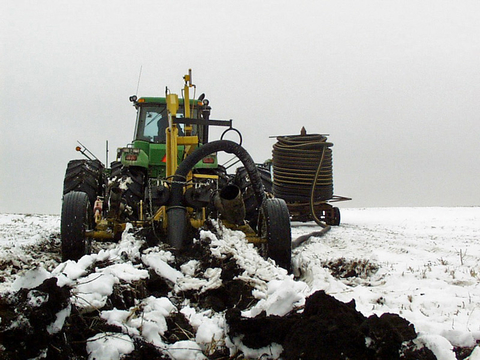Wetland compliance
Before starting a drainage project:
- File the Wetland Conservation Certification (Form 1026) with the Farm Service Agency (FSA).
- Complete the certified determination of wetlands (Figure 1) from the Natural Resources Conservation Service (NRCS). Compliance with federal Swampbuster rules is the operator’s responsibility.
- Visit your county Soil and Water Conservation District (SWCD) office to ensure you won’t be violating either the U.S. Army Corps of Engineers’ rules or the Minnesota Wetlands Conservation Act. Compliance with FSA rules doesn’t ensure compliance with either of these rules.
Public drainage systems
Only property that’s assigned benefits for a county or joint ditch or tile may be used for an outlet (Figure 2). If you’re planning to install a drainage system and intend to connect to a public ditch or tile system, visit your county ditch inspector to ensure you can do so.
Outlet capacity
Check to see that your outlet has the capacity to handle the amount of water you might be discharging into it at peak flow. An overloaded outlet will prevent your drainage system from functioning at its full design capacity.
Impacts on neighbors
It’s also a good idea to discuss your drainage project with neighbors if they’ll potentially be impacted or if you share a tile main or drainage ditch.
Drainage disputes can be a major cause of strife between neighbors. Be sure you’re not flooding your neighbors by sending your water on them, or overloading tile mains.
Return on investment
Investing in agricultural drainage is a business decision. Use good business practices by determining costs and projected returns while the project is still in the design phase.
Sound business practices dictate you should maximize your return on investment. This will ensure you don’t over-design the system, which could diminish profitability and have negative environmental consequences.
Land value
If it seems likely that a project will have marginal effectiveness or incur exceptionally high costs (frequently associated with the outlet), the land may be a candidate for a conservation program or even an outright sale.
Wetland restoration programs may offer high rental rates, at times offering the equivalent of the full property value in exchange for retiring the land. In some cases, you can even sell wetland mitigation credits for more than what the property is worth.
Pursuing these options can free up capital to purchase better farmland. Plus, you can streamline your farming operation by removing acres that are more challenging to farm. Consult with your county SWCD to see what programs or opportunities may be available.
Other problems to be fixed
While installing a drainage system, it may be a good time to assess and correct other problems.
For example, you may consider installing rock drains or coil drains to eliminate open intakes or have a professional evaluate open ditches to see if you need side inlet structures.
Design science and experience
There’s a difference between what works and what works best. Think about whether you’re choosing the correct tile layout, size, depth, spacing and grade.
Take the time to educate yourself on design methodology. Consider attending a drainage workshop that teaches the science of drainage design. The Minnesota Drainage Guide is a useful reference, as are other agricultural drainage articles.
Finally, consult with professionals who have design expertise, or even neighbors with a lot of drainage installation experience who’d be willing to assess your design.
Future drainage needs
Many farmers install drainage systems in phases. Make sure to install tile mains that have sufficient capacity for any future drainage.
Conservation drainage
Conservation drainage technologies and practices are readily available. These include woodchip bioreactors, saturated buffer drains, controlled drainage, alternative surface intakes and potentially other technologies.
The performance of these systems with respect to reducing flow and nitrates in discharge water is well-documented. Installing a conservation drainage technology currently isn’t a requirement, but you may determine you need to install something in the future.
Most of these technologies currently are a cost-sharable practice through the NRCS and some are through the Board of Water and Soil Resources (BWSR). Consider installing a drainage conservation practice that makes sense for your system and farm.
At a minimum, consider including conservation drainage practices at the time of design so one of these technologies can feasibly be retrofitted in the future as necessary. Consult with Extension or the NRCS staff to determine which design characteristics are necessary to accommodate a conservation drainage technology installation in the future.
Read more about these practices
Installer
Will you or a contractor be installing the drainage system? Tractor-mounted/pulled drainage plows (Figure 3) are increasingly popular, but there’s more to drainage installation than meets the eye.
Discuss installation with a local contractor before making the decision to install your own system. Ask yourself if you have the time, labor and know-how to do your own installation.
Reviewed in 2018




